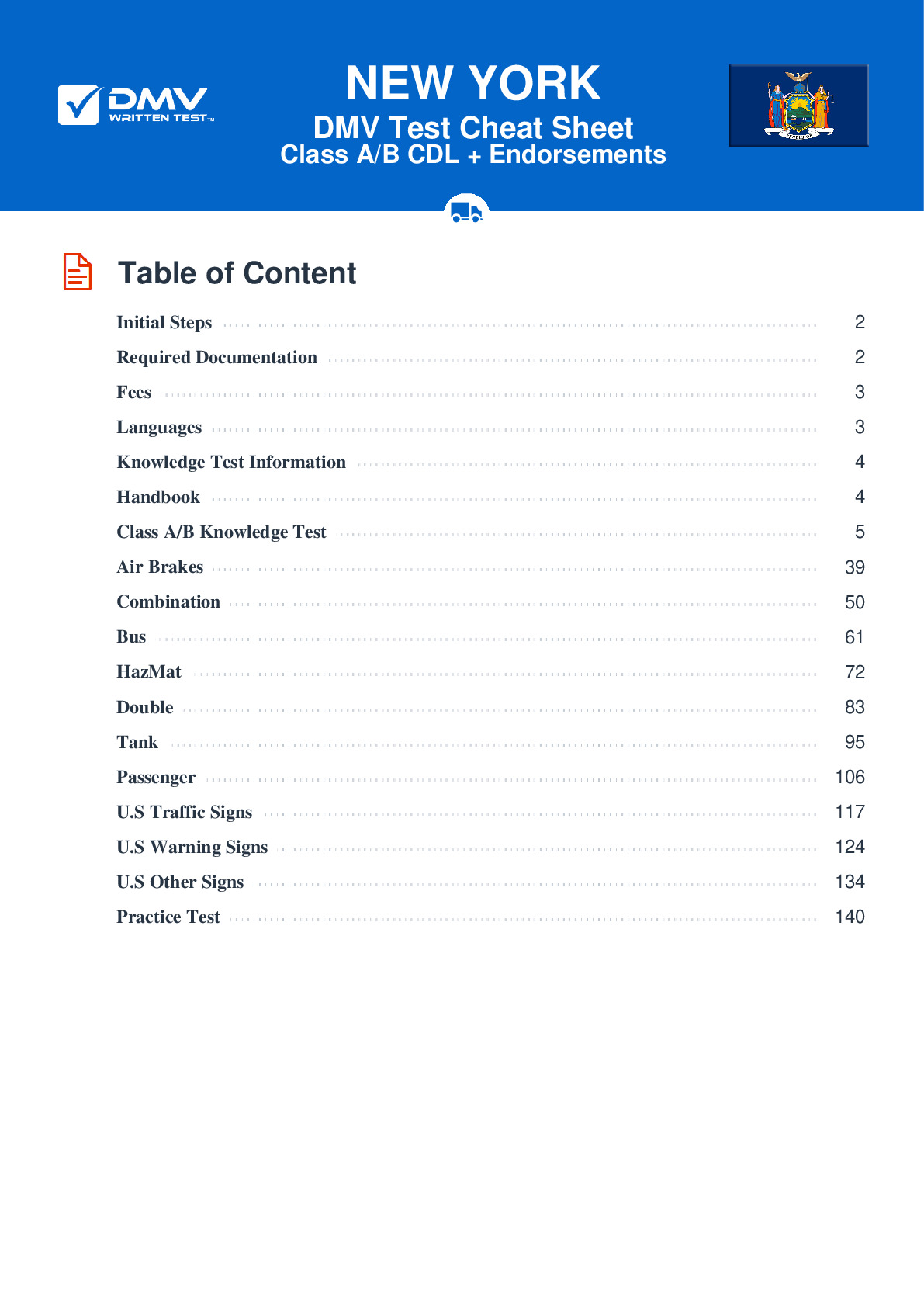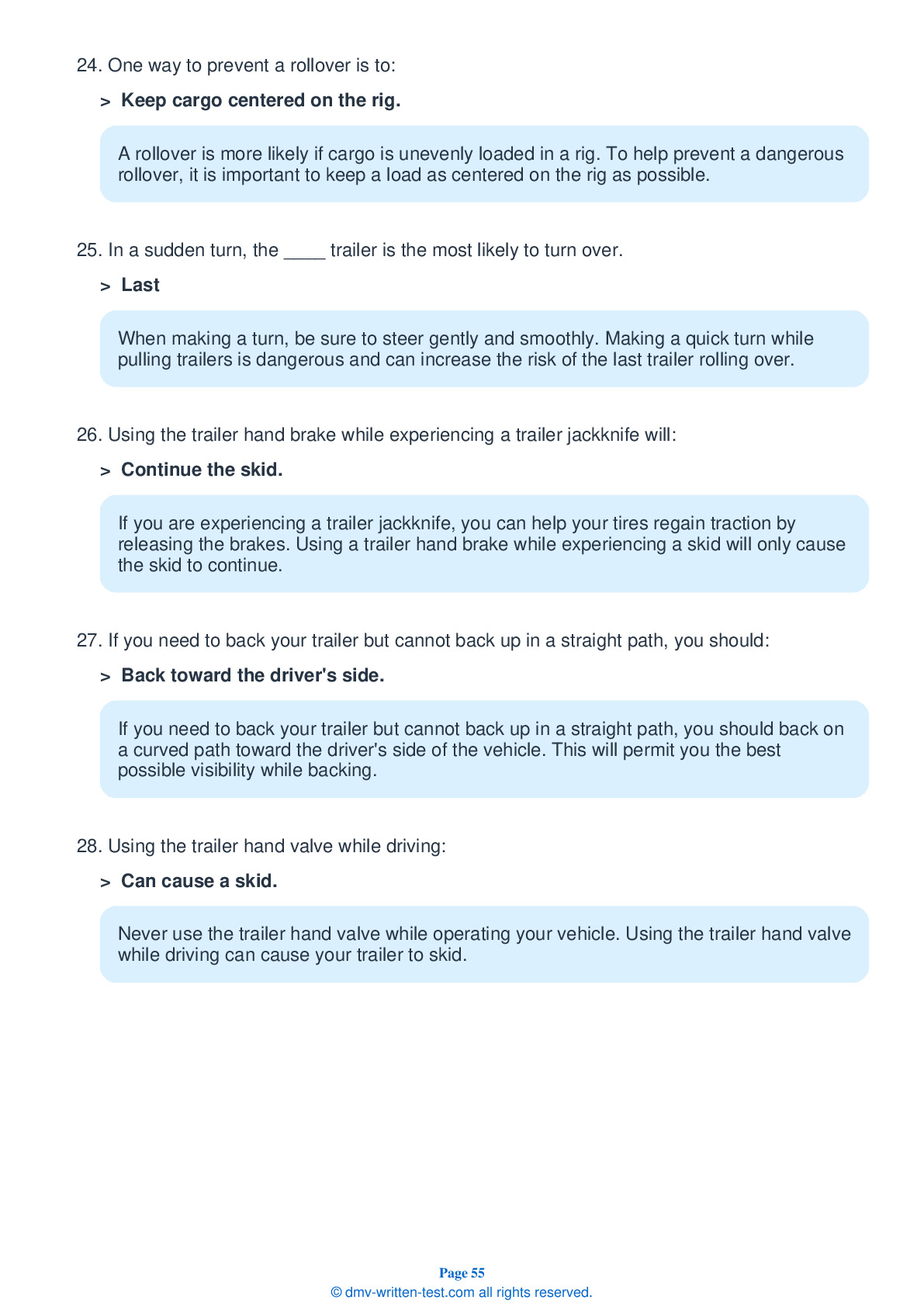Knowledge Test Class B
This license is required for driving a single vehicle with a GVWR of more than 26,001 pounds, and a trailer not to exceed 10,000 pounds gross vehicle weight rating, or a vehicle designed to transport 24 or more people (including the driver). To receive this license, applicants must pass a 50-question test. Each question has four answer choices. To pass, applicants must answer 40 questions correctly. Test questions come from the New York State Commercial Motor Vehicle Drivers Handbook. Questions come from chapters covering: Introduction, Driving Safely, Transporting Cargo Safely, Air Brakes (if applicable), Combination Vehicles, Pre-Trip Vehicle Inspection Test, Basic Vehicle Control Skills Test and On-Road Driving. Endorsements that may be used with a Class B CDL are: Hazardous materials, Tank, Passenger, HazMat and Tank, Air Brakes and School bus.
22. When testing a parking brake, the vehicle should:
To test a parking brake, you should fasten your safety belt, set the parking brake for the power unit, release the trailer parking brake (if applicable), place the vehicle in low gear, and attempt to pull forward against the parking brake. If the parking brake does not hold while you are attempting to pull forward against it, the brake is faulty and must be fixed.
23. What does an Anti-Lock Braking System (ABS) do?
The purpose of an Anti-Lock Braking System (ABS) is to prevent a vehicle's wheels from locking up when the driver brakes hard on a slippery surface.
24. During an applied leakage test, the maximum leakage rate for a single vehicle with air brakes is:
It is important to know the maximum air loss rate that is safe for your specific vehicle. A single vehicle with air brakes should have a leakage rate no higher than 3 psi in a minute during an applied leakage test.
25. If feeling tired and frequently yawning, you should:
Frequent yawning is a warning sign of fatigue. If you become tired while driving, the only safe response is to stop and get some sleep. You cannot rely on artificial stimulants, like caffeine, to keep you alert because they will eventually wear off and leave you more tired than you originally were.
26. The application pressure gauge:
In an air brake system, the application pressure gauge shows how much air pressure is being applied to the brakes. Not all vehicles with an air brake system have this gauge.
27. When starting a vehicle, the coolant temperature gauge should:
Keep an eye on the gauges after starting the engine. The coolant temperature gauge should begin a gradual rise to the normal operating range.
28. What is the Gross Vehicle Weight Rating (GVWR)?
The Gross Vehicle Weight (GVW) is the total weight of a single vehicle plus its load. The Gross Vehicle Weight Rating (GVWR) is the maximum combined weight of a vehicle and its cargo that is permitted and specified by the manufacturer.
Frequently Asked Questions
To obtain a Class B CDL license in New York, you will need to:
1. Be at least 18 years old.
2. Hold a valid New York State driver's license.
3. Obtain a commercial learner's permit (CLP) by passing the general knowledge and specific endorsement exams.
4. Complete any required training or endorsements for the type of vehicle you intend to drive.
5. Pass a road test in the type of vehicle you intend to drive.
6. Pay the appropriate fees.
It is important to note that there may be additional requirements depending on the specific type of commercial vehicle you intend to drive, such as passing additional endorsement exams or meeting medical requirements.
Some examples of vehicles you can operate with a Class B CDL license in New York include:
- Straight trucks (such as delivery trucks and dump trucks) with a GVWR of 26,001 pounds or more
- Large buses (such as school buses and passenger buses) designed to transport more than 15 passengers
- Segmental buses
- Box trucks and cube vans with attached trailers not exceeding 10,000 pounds GVWR
It is important to note that there may be additional endorsements or certifications required for certain types of commercial vehicles, such as hazardous materials or passenger endorsements.
It's important to note that some employers may have their own age requirements and may prefer drivers who are at least 21 years old. Additionally, certain types of commercial vehicles may require drivers to be at least 21 years old, such as those that transport hazardous materials or are involved in interstate commerce.
1. Passenger endorsement: This endorsement is required if you will be operating a vehicle designed to transport 16 or more passengers, including the driver.
2. School bus endorsement: If you will be operating a school bus, you will need this endorsement on your Class B CDL.
3. Tanker endorsement: This endorsement is required if you will be operating a vehicle that is designed to transport liquid or gaseous materials in tanks.
4. Hazardous materials endorsement: If you will be transporting hazardous materials, you will need this endorsement.
The specific endorsements required for your Class B CDL will depend on the type of commercial vehicle you plan to operate and the cargo you plan to transport. You may also need to pass additional knowledge and skills tests for each endorsement.
1. Pre-trip inspection: You will be asked to perform a thorough inspection of your commercial vehicle to ensure that it is safe and in good working condition. This includes checking the brakes, steering, suspension, tires, lights, and other safety features.
2. Basic vehicle control skills test: You will be asked to demonstrate your ability to control your commercial vehicle in a variety of situations, such as backing up, turning, and parking.
3. On-road driving test: You will be asked to drive your commercial vehicle on public roads while demonstrating your ability to safely operate the vehicle in traffic. This includes obeying traffic laws, using proper signals, and making safe lane changes.
During the entire test, you will be graded on your ability to safely operate your commercial vehicle and follow proper procedures. It's important to practice and prepare for the Class B CDL skills test in order to increase your chances of passing on your first attempt.
1. Vehicle type: A driver with a Class B CDL is only allowed to operate single vehicles with a gross vehicle weight rating (GVWR) of 26,001 pounds or more, or a combination of vehicles with a GVWR of less than 26,001 pounds towing a trailer with a GVWR of less than 10,000 pounds.
2. Passenger carrying: If you do not have a passenger endorsement on your Class B CDL, you are not allowed to operate a vehicle designed to transport 16 or more passengers (including the driver).
3. Hazardous materials: If you do not have a hazardous materials endorsement on your Class B CDL, you are not allowed to transport hazardous materials.
4. Air brakes: If you do not have an air brake endorsement on your Class B CDL, you are not allowed to operate vehicles with air brakes.
5. Time limitations: Some employers may have their own time limitations for drivers with a Class B CDL license, such as restrictions on how many hours you can drive per day or per week.
It's important to be aware of any restrictions or limitations that apply to your Class B CDL license and to follow all regulations in order to maintain your license and drive safely.
However, if you choose to take the test in a language other than English, you will need to bring an interpreter with you to translate the questions and answers. The interpreter must be at least 18 years old and cannot be a family member or business associate. You will also need to pay an additional fee for the interpreter.
It's important to note that even if you take the written test in a language other than English, you will still need to demonstrate your ability to read and understand English during the road test. This is because road signs and other important driving information are typically presented in English.
To request accommodations for the Class B CDL written test, you will need to fill out and submit a Request for Accommodations form to the DMV. This form is available on the DMV's website or at any DMV office. The form must be completed by you and your healthcare provider, who can provide documentation of your disability and any recommended accommodations.
Some examples of accommodations that may be available include additional testing time, a separate testing room, or special equipment or software. The DMV will review your request and determine what accommodations are appropriate based on your individual needs.
It's important to note that requests for accommodations must be made in advance of the scheduled test date. If you have any questions about requesting accommodations for the Class B CDL written test, you can contact the DMV's Disability Rights Coordinator at (518) 473-9550 or by email at drccoordinator@dmv.ny.gov.
In New York, you are allowed to take the written test three times in one day. If you fail the test three times in one day, you will need to wait until the following day to retake the test. If you fail the test three times on three separate days, you will need to wait at least 7 days before retaking the test.
When you retake the written test, you will need to pay the testing fee again. It's important to note that if you fail the written test three times, you will not be able to take the road test until you pass the written test.
It's a good idea to study and prepare thoroughly for the Class B CDL written test before taking it. The New York State Department of Motor Vehicles (DMV) provides a free Commercial Driver's Manual that covers all of the information you'll need to know for the written test. You can also find practice tests online or at your local DMV office.




